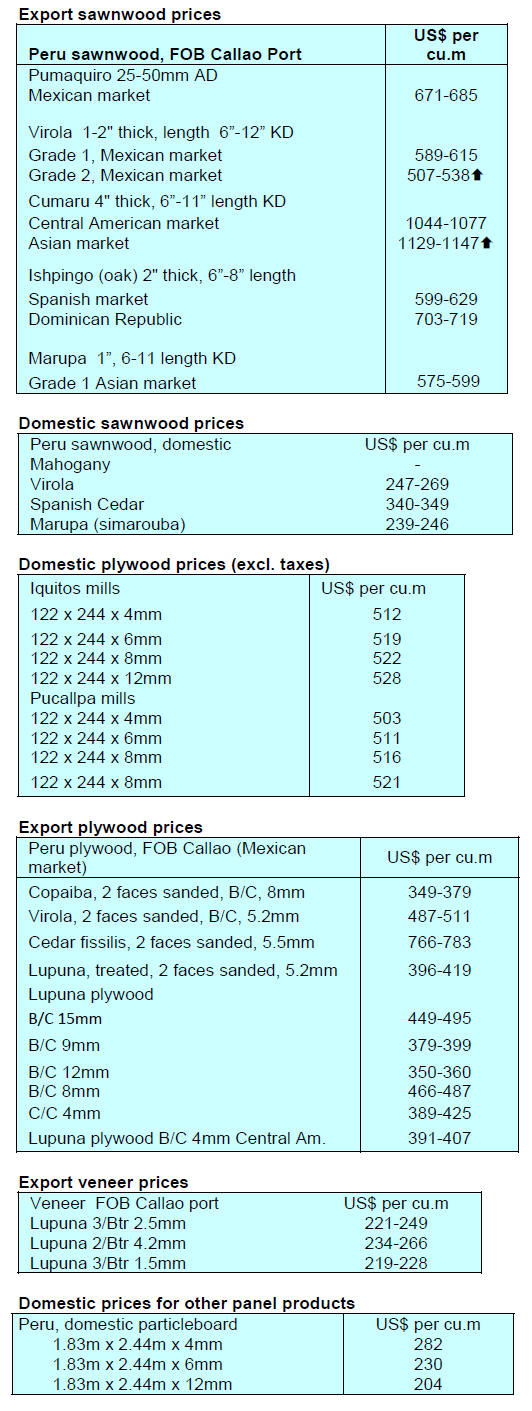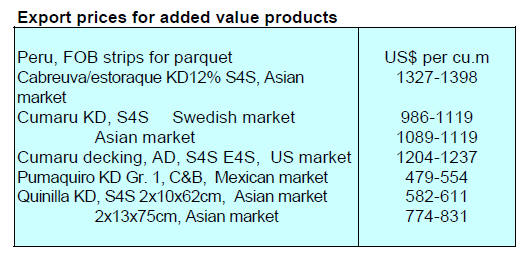4.
INDONESIA
Promote products in EU says
Ambassador
Desra Percaya, the Indonesian Ambassador to the UK, has
said Indonesian wood products have the potential to
expand market share in Europe from the current 2%. He
noted that British consumers demand sustainability so the
advantages of Indonesian wood products must be
promoted.
The Director General of Sustainable Forest Management
Ministry of Environment and Forestry, Agus Justianto,
stated that to strengthen market penetration it is necessary
to build upon the VPA. To this end he encouraged the UK
government and the European Union to explain to
consumers the efforts made by Indonesia and how the
VPA and SVLK is delivering sustainability.
See:
https://agroindonesia.co.id/perluas-pangsa-pasar-produkkayu-di-inggris-indonesia-punya-modal-kuat-lisensi-flegt/
Forest concessions revoked
Bahlil Lahadalia, the Minister for Investment has
confirmed that 15 forestry concession agreements have
been revoked on the recommendations of the Environment
and Forestry Ministry. Bahlil said that three companies
had forest area release rights (PKH) with a total area of
84,521.72 hectares.
The other 12 companies had forest concession business
licenses (PBPH) with a total area of 397,677 hectares.
Bahlil explained that there were 192 companies whose
licenses would be revoked but that 83 had requested
clarification.
See:
https://en.tempo.co/read/1576892/minister-bahlil-lahadaliarevokes-15-forestry-concession-permits
and
https://nasional.kontan.co.id/news/menteri-investasi-bahlillahadalia-cabut-15-izin-koinsesi-kawasan-hutan
Exports set a record in 2021
The Association of Indonesian Forest Concession Holders
(APHI) has reported that forestry sector exports were at a
record Rp.193.8 trillion in 2021. The chairman of APHI,
Indroyono Soesilo, said changes in international market
demand due to the adjustments to home-working and a
focus on renovation were mainly responsible for the
export growth.
Based on data from the Indonesian Forestry Society
Communication Forum (FKMPI) timber production from
plantation forests in 2021 reached 46.43 million cubic
metres an increase of 1.2% on an annual basis.
Meanwhile, wood production from natural forests rose
14.4% on an annual basis to 6.013 million cubic metres.
Last year forestry sector exports increased by 31% on an
annual basis from US$11.07 billion in 2020 to US$ 14.48
billion. The wood chip industry experienced the highest
growth of over 90% from US$50.45 million to US$96.24
million. The largest contributor to the export growth was
the wood panel industry which earned US$3.97 billion, up
83% on an annual basis. Second was the paper and pulp
industry with the exports of US$ 3.72 billion and US$
3.19 billion.
See:
https://katadata.co.id/tiakomalasari/berita/624ea598b7d9e/efekpandemi-ekspor-industri-hasil-hutan-cetak-rekor-di-2021
Finnish technology for wood product manufacturing
The Association of Indonesian Forest Concession Holders
(APHI) is exploring cooperation with Finnish forestry
businesses through the ‘Business Finland’ a Finnish
government initiative.
At a meeting initiated by the Indonesian Embassy in
Helsinki both parties agreed to further discuss three areas
for possible collaboration:
the use of satellite data for the forest areas
determination and the calculation of carbon
sequestration
the development of forest product-based bio
products
the use of wood biomass for new and renewable
energy
Nina Jacoby the Senior Advisor ‘Business Finland’ said
Finland used to be known as a producer and exporter of
pulp and paper products but not any longer as the country
produces more varied bio-products including
nanocellulose as a substitute for plastics, various health
products and a variety of other high tech products.
See:
https://forestinsights.id/2022/04/07/aphi-jajaki-kerja-samadengan-finlandia-incar-teknologi-pemanfaatan-hasil-hutan/
Digital transformation for sustainable forest
management
The Secretary General of the Ministry of Environment and
Forestry, Bambang Hendroyono, speaking at a National
Seminar on Digital Transformation Supporting Forestry
4.0 Innovation for a Green Economy said digital
transformation can support efficient sustainable forest
management through integrated and transparent
monitoring of environmental conditions. He added that
‘Forestry 4.0’ will lead tech-intelligent forest
management.
The development of technology and information systems
can be used to monitor changes in the rate of deforestation
every year allowing the development of integrated
sustainable forest management information systems to
increase productivity in accordance with environmental
principles.
See:
https://wartaekonomi.co.id/read402497/klhk-dorongtransformasi-digital-inovasi-kehutanan-40-untuk-ekonomi-hijaupenyelamatan-bumi
Indonesia monitors hotspots as dry season
approaches
Indonesia's Ministry of Environment and Forestry is
continuing to monitor fire hotspots in regions prone to
forest and land fires as well as carrying out fire mitigation
efforts in several regions. The ministry has also continued
to urge regional governments to raise their alertness and
prioritise prevention efforts.
Improving early detection and hotspot monitoring is done
through the website
www.sipongi.menlhk.go.id.
See:
https://www.medcom.id/english/national/nN9XBZAKindonesia-monitors-hotspots-as-dry-season-approaches
BMKG forecasts higher potential of forest and land
fires in 2022
The Indonesian Meteorology, Climatology and
Geophysics Agency (BMKG) has warned of the potential
for forest and land fires to be greater in 2022. Acting
Deputy of Climatology at BMKG, Urip Haryoko, noted
that this year the dry season is expected to normal
compared to last year when there was unexpected rain
during the dry season. During a press conference Haryoko
commented that several hotspots were currently being
monitored such as in Aceh, Riau, South Sumatra, North
Sumatra, Bangka Belitung Islands and West Kalimantan.
See:
https://en.antaranews.com/news/220713/bmkg-forecastshigher-potential-of-forest-land-fires-in-2022
Indonesia has shown tremendous effort to reduce
deforestation - FAO
FAO Indonesia noted in a statement to welcome the
International Day of Forests that, despite all the priceless
ecological, economic, social and health benefits forests
provide, global deforestation continues at an alarming rate.
The world is losing 10 million hectares of forest a year –
more than half the size of Sulawesi – and land degradation
affects almost 2 billion hectares, an area larger than South
America.
Forest loss and degradation emit enormous quantities of
climate-warming gases and it is estimated that more than
eight percent of forest plants and five percent of forest
animals and birds are at “extremely considerable risk” of
extinction.
The statement says “the government of Indonesia has
shown tremendous effort to reduce deforestation. We need
to appreciate this effort by supporting the Indonesian
government to enforce the law to protect the forest and the
forest community as the fundamental aspects in managing
sustainable forest”.
Indonesia’s G-20 presidency also boosts Indonesia's
programme to achieve sustainable economic development
and the year 2045 targets to include sustainable
management of forests.
See:
https://www.fao.org/indonesia/news/detailevents/ru/c/1479558/
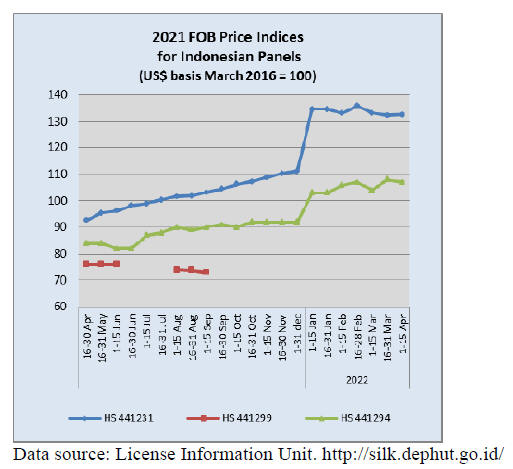
5.
MYANMAR
Logging moratorium extended
The Ministry of Natural Resources and Environmental
Conservation (MONREC) has announced an extension of
the logging moratorium for one more year. Myanmar
implemented a one-year nationwide logging ban in 2016-
17 and 10-year moratorium for Bago Yoma Range from
2016 to 2025.
The moratorium did not have much impact on output as
the productsfrom the new log stocks are unacceptable in
the EU and the USA but not other markets.
Currently Myanmar millers and manufacturers are trying
to source logs harvested before the restrictions in the belief
that the EU and US sanctions will not apply to products
manufactured from such old logs. There is, however,
controversy on the legal basis for this assumption. It is
understood that the Myanma Timber Enterprise (MTE)
may have around 20,000 tons of logs harvested before the
sanctions were imposed but this has not been confirmed.
New foreign exchange rules
On 3 April the Myanmar Central Bank (MCB) issued a
requirement that incoming foreign exchange must be
converted to local currency within one working day which
has caused panic among traders in all sectors.
For more see:
https://www.mizzima.com/article/myanmar-citizens-toldforeign-exchange-deposits-must-be-converted-kyat
https://elevenmyanmar.com/news/cbm-eases-cash-withdrawalrestrictions%E3
https://asia.nikkei.com/Business/Markets/Currencies/Myanmarcentral-bank-says-FX-deposits-must-be-converted-into-kyat
https://www.mizzima.com/article/myanmar-citizens-toldforeign-exchange-deposits-must-be-converted-kyat)
https://elevenmyanmar.com/news/cbm-eases-cash-withdrawalrestrictions%E3
For the timber sector the situation is unique in that millers
are required to pay in US dollars for logs purchased from
the MTE, the sole legal source of logs. With the new
Central Bank requirement millers will have no hard
currency to buy logs. It is not yet clear if MTE will accept
the local currency. Until the recent change exporters had
been allowed to keep US dollars for one month.
The latest measure from the administration in Myanmar to
tighten the foreign regulation comes as the US dollar has
appreciated sharply this year. The Central Bank set a fixed
rate at Kyat 1850/US dollar which is far below the
unofficial rate. Exporters and importers fear such drastic
action will be very disruptive and could impact trade and
investment.
The local media has reported some reactions to this new
rule saying the Japanese Embassy in Naypyitaw urged
reconsideration warning of "significant difficulties" for
Japanese companies and aid organisations operating in the
country.
In related news, the Central Bank has issued an order
dated 1 April instructing banks to allow cash withdrawals
for salaries and wages of the factories in industrial zones
without limit and a weekly withdrawal of up to Ks100
million for purchase of raw materials and the businesses
operating with government budgets.
This was possible according to the Central Bank as cash
flow management in the banks in Myanmar has improved.
6. INDIA
Australia and India
free tade deal
Australia and India have signed an interim free-trade deal
aimed at diversifying export markets and
reducing Australia's economic dependence on China.
Indian exporters from sectors including textiles, leather,
furniture, jewelry and machinery will enjoy duty free
access to the Australian market. Australia is offering zero
duty access to India on about 96 of the value exports.
Currently exports attract 4-5% customs duty in Australia.
Australia and India began talks on the trade deal back in
2011 but discussions became bogged down and were
suspended in 2015. Last year the two countries agreed to
"re-engage" on the deal when Australia and India
upgraded their relationship to a Comprehensive Strategic
Partnership.
Australia is the 17th largest trading partner of India and
India is Australia's 9th largest partner. Bilateral trade in
goods and services stood at $27.5 billion in 2021.
See:
https://www.thehindu.com/business/india-australia-to-signinterim-trade-pact-on-saturday-2-april-2022-thousands-of-indianexports-to-get-duty-free-access/article65282723.ece
In related news, India’s exports exceeded the US$400
billion mark last year. Exports grew almost 40% compared
to the previous fiscal year. India’s imports also rose to a
record high. Engineeed goods were the largest contributor
to the growth in exports.
Piyush Goyal, Minister for Commerce and Industry said
that India had significantly boosted exports to key trading
partners with outbound shipments to the UAE increasing
by 65% and exports to the US increasing by 45%.
However, risks to a global economic recovery due to
invasion of Ukraine by Rusia could undermine export
growth.
Housing demand increased in last quarter of 2021
The residential real estate industry is showing signs of
recovery as is shown by the Magicbricks PropIndex for the
September quarter 2021 and prices for completed units
increased almost 6% nationwide.
Sudhir Pai, Magicbricks CEO, is reported as saying
“Increasing project completions, attractive offers from
developers, supportive policies and improving
employment opportunities have boosted buyer-confidence
in the real-estate industry.
While the present geopolitical situation is impacting the
supply chain and input costs we expect the momentum
gained thus far to continue across demand and supply
backed by new launches tailored to the evolving needs of
consumers and all-time low home loan interest rates,”
See:
https://www.moneycontrol.com/news/business/realestate/housing-demand-increases-by-6-7-yoy-report-8331411.html


7.
VIETNAM
Wood and wood product trade highlights
According to data provided by the General Department of
Customs in March 2022, Exports of wood and wood
products to the EU reached US$71.3 million, up 0.4%
compared to March 2021 and up over 6% for the entire
year.
Bedroom furniture exports in March 2022 are estimated at
US$225 million, up 0.6% compared to March 2021.
In the first 3 months of 2022 bedroom furniture exports
are estimated at US$578 million, up 0.9% over the same
period in 2021.
Oak imports
Vietnam's oak imports in March 2022 are estimated at
16,500 cu.m, worth ÚS$10.0 million, up 14.9% in volume
and 15.2% in value compared to February 2022.
Compared to March 2021 imports decreased by almost
50% in volume and 40% in value.
In the first 3 months of 2022 oak imports reached 50,000
cu.m, worth US$29.8 million, down 41.5% in volume and
30.3% in value compared to the same period in 2021.
Vietnam's oak imports from the US were the largest in the
first two months of 2022 reaching 21,400 cu.m worth
US$12.8 million, down 43% in volume and 30% in value
compared to the same period in 2021 and accounted for
64% of total oak imports from all sources.
Vietnam furniture matching week 2022
This event is intended to help local firms expand their
business network and further integrate into global supply
chains.
The COVID-19 pandemic and global uncertainties have
disrupted supply chains and led to high logistics costs.
Therefore, the event is expected to support domestic
furniture and handicraft firms not only to expand their
consumption markets but also access the best logistics
services.
The event included Furniture Sourcing Day which
enabled businesses to approach international buyers and
suppliers of support services as well as exchanges and
workshops.
Online activities will take place on the HOPE
(Hopefair.com) platform, which has been upgraded to
make it easier for participating businesses and
international buyers to hold meetings at anytime and
anywhere.
See:
https://en.vietnamplus.vn/vietnamese-furniture-firms-striveto-further-join-global-supply-chain/224257.vnp
Risk of stagnation the timber sector – Industry
associations agree plan for a modern processing
sector
Growth in Vietnam’s wood and timber industry is under
threat of stagnation but the establishment of an interregional
timber centre could help boost the sector.
Vietnam’s furniture processing and exporting industry
ranks second in Asia, after China and fifth in the world in
terms of export earnings but challenges are emerging
putting pressure on the goal of reaching exports of US$20
billion by 2025.
The supply of wood raw material is one of the biggest
bottlenecks and could derail the industry. Afforestation
could not meet the demand for raw materials for the wood
processing industry which is growing at a high rate.
Data from the General Statistics Office showed that the
output of timber harvested from planted forests has
continuously increased over the years from 3.01 million
cubic metres in 2006 to 19.5 million cu.m in 2019. It is
estimated that in 2020 it reached around 20.5 million cubic
metres, achieving the target set in the development
strategy for 2006-2020.
According to statistics, currently the domestic supply of
raw materials can only meet about 75% of the total
processing demand, including the exploitation of
cultivated forests and extraction of scattered crops and
rubber wood.
Each year, Vietnam still has to import about 8.5 million
cubic meters of wood, accounting for 25% of the total
volume for the wood processing industry. At first glance,
75% of domestic raw materials is not a small amount, but
the problem is that the certified forest area only accounts
for 8.4% of the total cultivated forest area of the country,
covering about 307,000 hectares. However, the area of
forest planted by households is mainly for small wood.
Among the major markets with a furniture consumption
above US$5 billion a year. Europe and Asia are expected
to have the strongest growth in furniture and outdoor
furniture. Besides this, the main market for Vietnam’s
wood industry, North America will continue to grow
steadily.
This forecast fits well with Vietnam’s overall strategy and
a plan to develop a modern wood industry that ensures
harmony between all stakeholders was approved by the
five wood associations including the Association of
Vietnam Timber and Forest Product (VIFORESTrest), the
Dong Nai Wood and Handicraft Association, the
Handicraft and Wood Industry Association of Ho Chi
Minh City, the Binh Duong Furniture Association and the
Forest Products Association of Binh Dinh.
See:
https://vir.com.vn/fresh-collaborations-emerging-in-woodand-timber-industry-91827.html
and
See:
https://en.vietnamplus.vn/five-agricultural-and-forestrymaterial-areas-to-be-set-up/224295.vnp
Vietnamese wood industry targets high growth
The aim of a sustainable wood processing industry in
Vietnam, for the period 2021 to 2030 is to achieve exports
of US$25 billion. However, to accomplish this ambitious
goal the wood industry needs to remove many bottlenecks
in the supply of raw materials, increase labour productivity
and gain better access to production technology.
Growth target
In the first three months of the year exports by wood
industry reached US$3.94 billon, up by 3% compared to
2021. Furniture businesses are now full with orders until
the third quarter and some businesses even have orders
until the end of the year.
If the average export value is kept at about US$1.5 billion
per month the target of reaching US$16.5 billion this year
is quite feasible.
In 2021, despite many difficulties associated with to the
Covid-19 pandemic, in the third quarter the wood industry
still maintained its position among the top export
industries in the country at over US$10 billion.
Specifically, the industry reached a target of US$14.8
billion, an increase of nearly 20% compared to 2020.
Vietnam's wood and wood products, as well as furniture
are continuously being ranked in the top ten industries
with the largest export turnover in the country. It is an
industry that has brought in the third largest export surplus
in recent years, contributing an important source of foreign
currency to the country’s foreign exchange reserves.
The woodworking and furniture manufacturing industries
contribute greatly to jobs creation providing more than
half a million jobs ranking fifth in the number of workers
among the manufacturing and processing industries.
Nguyen Liem, Chairman of the Binh Duong Wood
Processing Association, said that the labour force in Binh
Duong province has dropped by 100,000 compared to one
year ago. The reason is because of the Covid-19 pandemic
many workers returned to their hometowns.
Now many provinces and cities in the Mekong Delta and
the Central parts of the country have established industrial
zones which should attract workers back to the locality to
work. In the long term enterprises in the wood industry
must focus on solutions to improve productivity and invest
in better equipment. Investment in equipment and
machinery alone is not simple.
For large-scale factories it is still possible but for small
and medium-sized factories, it is not easy to find extra
investment capital.
See:https://en.diendandoanhnghiep.vn/vietnamese-woodindustry-targets-high-growth-n33931.html
8. BRAZIL
Furniture industry growth
Furniture sector statistics from IEMI for 2021 and early
2022 have been reported by the Brazilian Association of
Furniture Industries (ABIMÓVEL). According to IEMI,
furniture production in 2021 was close to that of 2020, at
around 421.2 million pieces valued at R$76 billion.
The Brazilian furniture industry ended 2021 with a year on
year 6.4% increase in revenue and exports jumped 50%.
According to the ABIMÓVEL report the average price of
furniture continues to increase and reached R$194.00 per
piece in the first month of this year, a 0.4% increase
compared to the previous month and up 17% year on year.
Furniture exports start 2022 on a bright note
Furniture exports in January 2022 were worth US$58.1
million (FOB) representing a 27% increase compared to
January 2021.
Wooden furniture represented 87% of the total that is
about US$50.3 million (FOB) according to ABIMÓVEL
and Apex-Brazil (Association of Export and Investment
Promotion).
The main destinations for Brazilian furniture exports were
the United States accounting for 36% of exports followed
by the United Kingdom with 11% in January 2022. The
UK participation was driven by a growth of 39% in the
last 12 months. The highlight was the Netherlands where
export jumped almost 300% year on year.
The main focus of the recent Apex-Brazil project was the
Dubai Trade show where prospective business was around
US$18.4 million in the United Arab Emirates, a 99%
growth in 12 months and for Saudi Arabia a growth of
over 200% was registered.
Furniture sector fairs in 2022
The Movelsul fair, the main furniture fair in Latin
America in terms of exhibition area, number of exhibitors
and visitors and the International Fair of Suppliers of
Wood and Furniture Production Chain – FIMMA, one of
the largest fairs in the sector were held in March in Rio
Grande do Sul. Rio Grande do Sul state has approximately
2,800 furniture industries, generating around 35,000 direct
jobs. The state is also the second largest exporter of
furniture in Brazil.
The Movelsul and Fimma fairs took place simultaneously
for the first time and more than 30,000 visitors from 41
countries attended. Fimma generated R$1.7 billion in sales
opportunities while Movelsul generated over R$ 370
million.
SpaceX technology for development of the Amazon
Region
SpaceX's technology has been in the news as the
multinational company has held talks with the Brazilian
Government on support for activities in the Amazon
Forest. SpaceX plans to announce operations of the
"Starlink" satellite system for the Amazon Region.
See:
https://www.aljazeera.com/economy/2021/11/16/musk-intalks-with-brazil-on-monitoring-amazon-rainforest
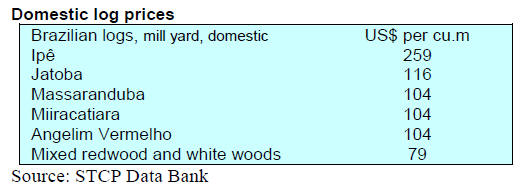
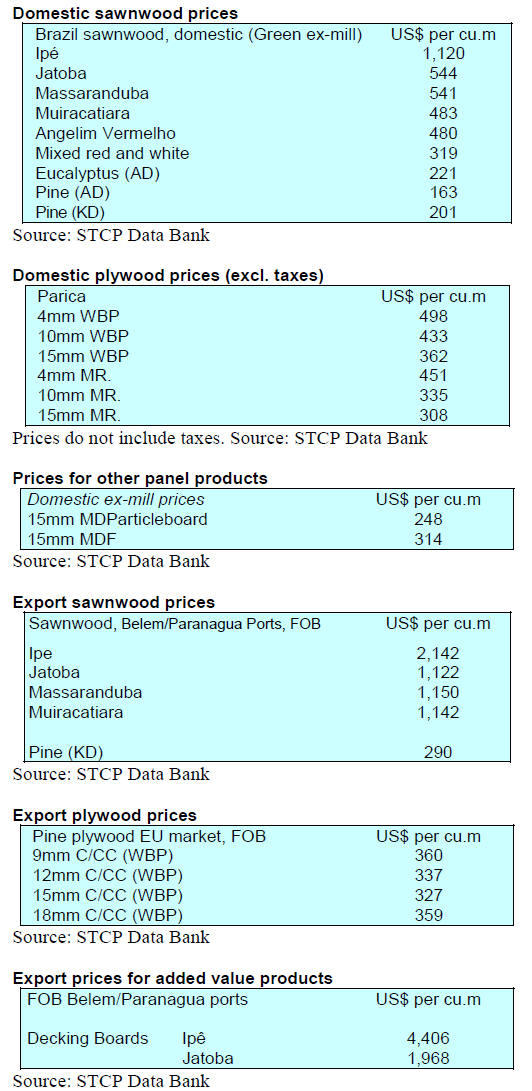
9. PERU
Exports grow in the first two months
of the year
In the first two months of 2022 exports totaled US$8,864
million, a slight growth of 2.5% compared to the same
period last year mainly due to increased exports of the socalled
‘non-traditional’ products according to the
Economics Research Center and Global Business of the
Association of Exporters CIEN-ADEX.
The low growth in the first two months of the year is due
to the 5% contraction of traditional shipments such as
minerals and marine products. Oil shipments doubled.
China and the US accounted for almost 45% of total
exports. Other destinations were India, South Korea,
Japan, Canada, United Kingdom, Switzerland, the
Netherlands and Chile.
Coordination of efforts to prevent forest fires
At the end of March the National Forest and Wildlife
Service (SERFOR) and regional governments met
virtually to establish a virtual course “Forest fire risk
management in the field of regional governments”.
This course will target farmers. SERFOR has determined
there is a need to continue developing training modules to
encourage regional and local governments to prepare
specific risk management plans for forest fires.
OSINFOR presents mobile application "IDArbol"
The Supervision Agency for Forest Resources and Wild
Fauna (OSINFOR) has made available the IDArbol mobile
application. This is a digital tool with updated and detailed
information that, even without connection to internet,
allows identification of over 100 timber species.
During a presentation made at the National Amazonian
University of Madre de Dios (UNAMAD), Lucetty Ullilén
Vega, head of OSINFOR highlighted the importance of
this application allowing operators to correctly identify
species.
The application has a preventive approach so that forest
concession holders do not make errors or omissions when
formulating their forest management plans. This tool has
dendrological information on more than 100 timber
species and includes a search system based on keys with
two answers. IDArbol is free and is available on Google
Play for all types of cell phones.
See:
https://elcomercio.pe/lima/sucesos/osinfor-lanza-aplicativomovil-para-identificar-especies-forestales-en-los-bosques-serforidarbol-rmmn-noticia/
Strengthen initiatives in forestry sector
The Technological Institute of Production (ITP), a body
attached to the Ministry of Production (Produce) has
through CITEmadera Lima, signed an inter-institutional
cooperation agreement with the NGO WWF Peru in order
to strengthen joint initiatives related to the improvement of
capacities, scientific research, collaboration and
development of projects in the forestry sector.
This joint effort is aimed at combating illegal logging and
associated deforestation. The agreement is for four years.
See:
https://www.wwf.org.pe/informate/noticias/?uNewsID=376152
